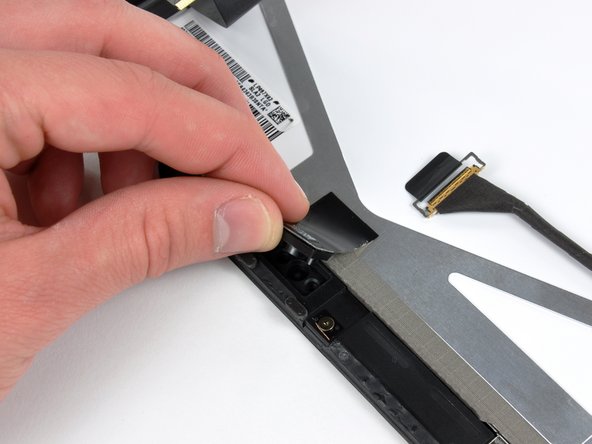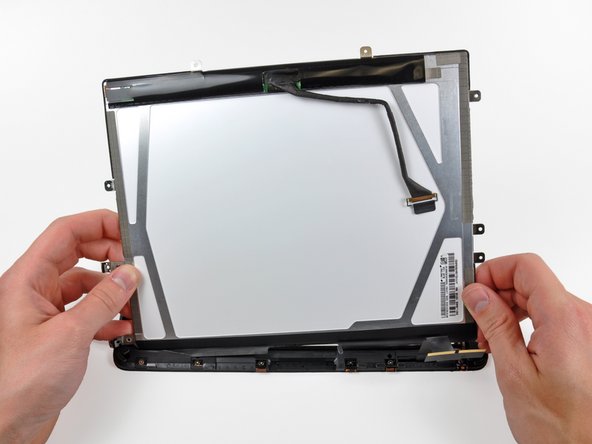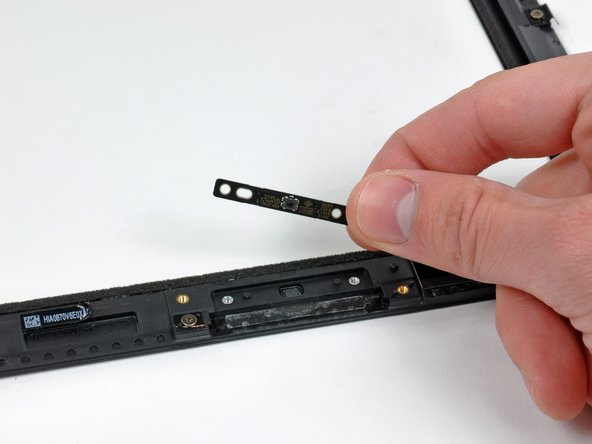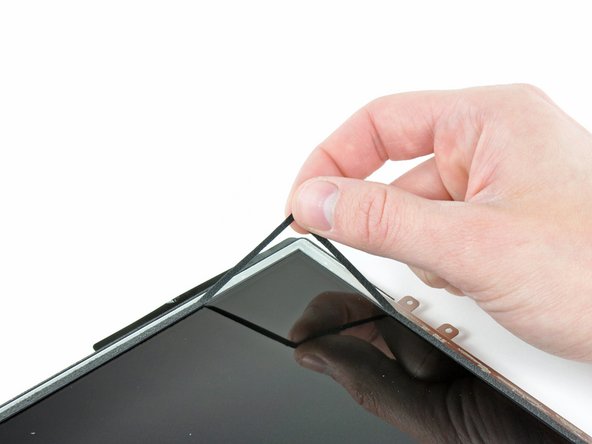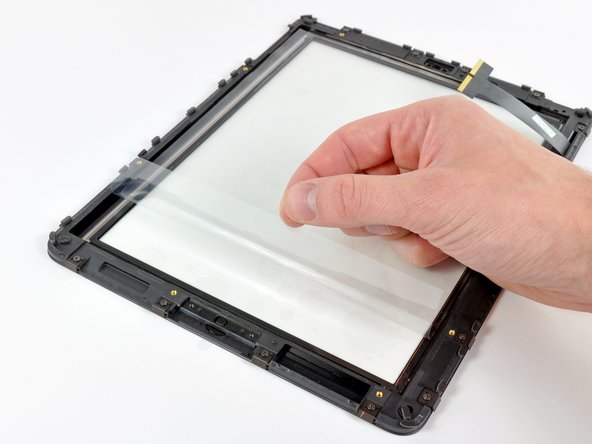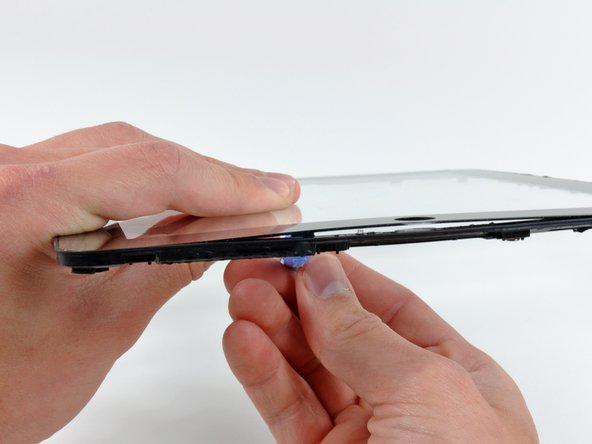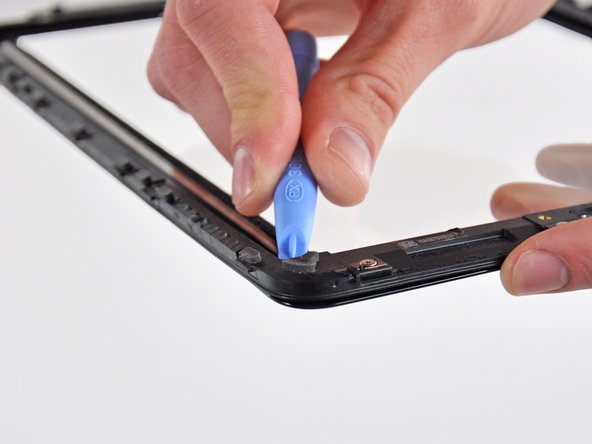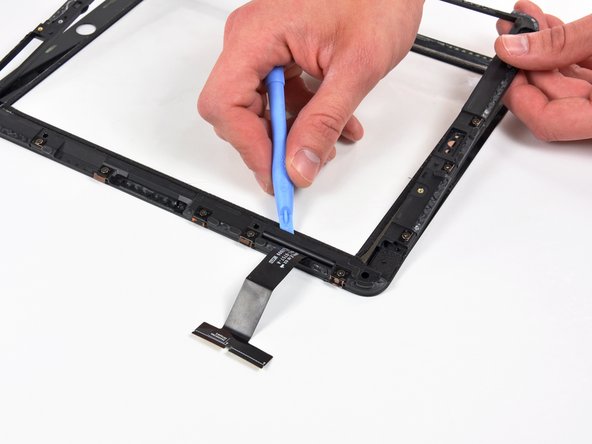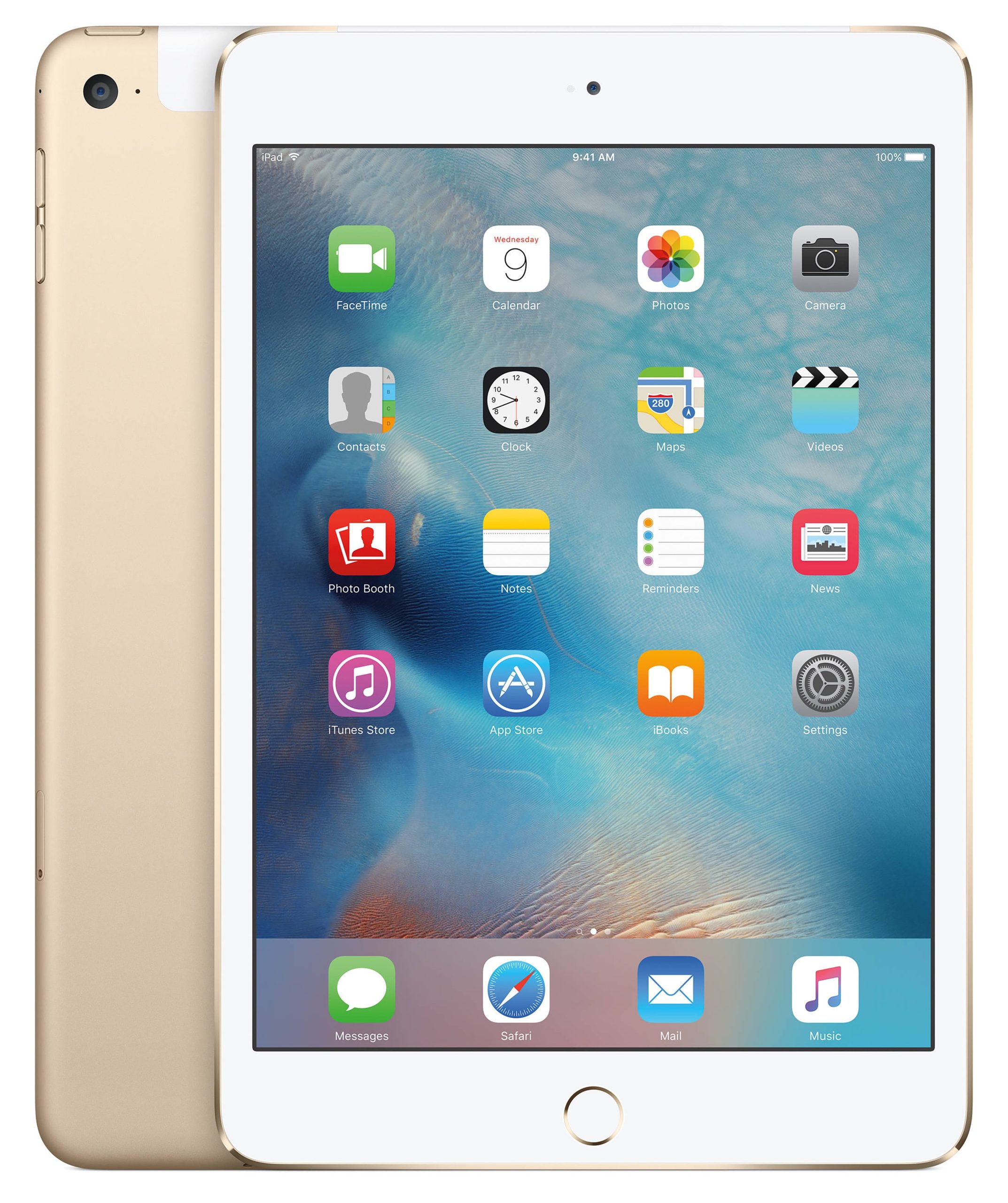How to Replace iPad Wi-Fi Display Frame – DIY Guide
Duration: 45 minutes
Steps: 33 Steps
Hey there! Just a friendly reminder: before diving into this repair, make sure you’ve got all your tools and parts ready to go. We want you to be fully prepared for the adventure ahead! And remember, if you run into any hiccups or need a hand, you can always schedule a repair. Happy fixing!
Get ready to tackle that pesky broken display frame! If you’ve got a shattered glass panel instead, don’t fret—just check out our front panel assembly guide. And remember, if you need a hand, you can always schedule a repair.
Step 1
Put on those snazzy safety glasses to keep your peepers safe, and take it easy on that delicate LCD screen – we want it to stay intact!
– If your display glass is sporting some cracks, let’s keep it together and avoid any mishaps during your repair by adding some tape. Safety first!
– Grab some clear packing tape and lay overlapping strips over the iPad’s display until it’s fully covered like a cozy blanket.
– Try to stick with the rest of the guide as best as you can. Just a heads up, once the glass starts breaking, it might keep on cracking as you go. You might need to whip out a metal prying tool to help scoop out the glass.
Step 2
– There are 14 little metal clips holding the display assembly snug as a bug. As you gently pry in the upcoming steps, aim to work around these clips and avoid slicing through them with your trusty opening tool. You’ve got this!
Step 3
– Slide a metal spudger into the gap between the top edge of the display assembly and the rear panel assembly.
– Gently twist the spudger away from you to pop those tabs loose along the top edge of the display.
– Now, grab a second metal spudger and wedge it in the same spot to keep those tabs from snapping back. You’ve got this!
Tools Used
Step 4
Pry with care and ease—if you encounter any stubborn spots, take a breather and try a different area.
– Grab your trusty spudger and gently glide it along the right edge of your iPad.
– The front panel is snugly held to the aluminum back with metal clips at the top, bottom, and left sides. On the right side, you’ll find some plastic tabs that fit into little recesses in the backplate.
– Once you’ve freed those clips, carefully lift the left side of the front panel and slide it to the left to pop those tabs out of the aluminum backplate.
Tools Used
Step 6
– Next up, it’s time to gracefully disconnect the three cables linking the display assembly to the logic board. These cables are the lifelines for the following components:
Step 7
Just a friendly reminder: make sure you’re lifting the retaining flap, not the socket itself!
– Grab your trusty plastic opening tool and gently lift up those little retaining flaps that are keeping the digitizer ribbon cables snug in their sockets on the logic board.
– Now, carefully pull the digitizer ribbon cables straight out of their cozy homes. You’ve got this!
Step 8
– Grab your trusty plastic opening tool and gently nudge the ambient light sensor connector upward to free it from its cozy little socket. You’ve got this!
Step 9
Gently tug the connector straight out, keeping it parallel to the logic board’s face. You’ve got this!
– Gently lift the metal retainer by its black plastic pull tab to free the display data cable from the main board. You’re almost there!
– Carefully pull the cable connector away from its socket. Easy peasy!
Step 10
– Gently detach the display assembly from the rear panel assembly. You’re on the right track!
Step 11
Watch out for that ambient light sensor! Keep it safe and sound by avoiding any creases below its top section, or you might just end up with a piece that has adhesive going solo. Let’s keep everything in one piece!
If you’re reusing the LCD, feel free to leave the ambient light sensor snugly attached to the back of it. No need to peel it off!
– Grab your trusty plastic opening tool and gently wiggle it around the edge of the ambient light sensor board to loosen it from the sticky adhesive holding it to the display frame. Go slow and steady!
– Once you’ve created a little breathing room, carefully peel the ambient light sensor away from the LCD like a pro.
– If you need to, feel free to attach the plastic view window to your shiny new ambient light sensor before you pop it in place.
Step 13
– Let’s kick things off by unscrewing those three T5 Torx screws that are holding down the clips and LCD brackets, which are cozily wrapped in EMI tape near the home button switch.
– Now, gently peel away the display clip along with its tape from the black plastic display frame. Take your time; it’s a delicate dance!
– If you’re swapping out the LCD, remember to bring over those little pieces of EMI tape and their trusty clips to the new LCD. It’s like passing the baton in a relay race!
Step 15
Just a friendly reminder: try not to give that LCD too much of a bend! It’s made of glass, and we want to keep it in one piece.
– Slide the edge of a trusty plastic opening tool under one of the little ears on the steel LCD frame.
– Give that plastic tool a gentle twist to lift the LCD away from the adhesive that’s been holding it snugly against the front glass panel.
Step 18
– If your screen’s still feeling a bit clingy to the front panel, gently peel away the strip of EMI tape located near the ambient light sensor socket.
– If it’s needed, don’t forget to give that tape a new home on your shiny new LCD.
– If the tape is cozy with the LCD and you’re keeping the same one, feel free to skip this step. But if you’re swapping out the LCD too, make sure to move that strip of EMI tape over to your new LCD.
Step 19
– If they’re still looking good, go ahead and move those clips and EMI tape from the bottom of the old LCD to your shiny new one.
Step 20
– First up, let’s tackle those two T5 Torx screws that are holding the home button switch snugly to the plastic display frame. Time to set them free!
– Once those screws are out, gently lift the home button switch board away from the front panel assembly. You’ve got this!
Step 21
– If you’re planning to give your LCD a second chance, grab a plastic opening tool and gently nudge a corner of that foam tape off the LCD. It’s like peeling a sticker, but cooler!
– Once you’ve freed the corner, go ahead and peel off the tape that hugs the edges of the glass face. It’s time to let that LCD breathe!
Step 22
Watch out for fingerprints and dust on the inner side of the front panel! They’ll be like little gremlins, popping up and waving hello when your device is on. Keep it clean for a smooth view!
– Gently take off that piece of yellow tape holding the digitizer cable in place on the inner side of the front panel assembly. Just be careful not to tug on the cable too hard—it’s delicate!
– Next up, peel away the protective sheeting from the inner face of the front panel assembly. You’re doing great!
Step 23
Make sure the LCD screen is squeaky clean before diving in!
Step 24
When swapping out your panel for a shiny new one, keep in mind that it might come with a protective film on the outside and/or inside of the frame. Don’t forget to peel it off before moving forward.
– Gently peel back the EMI tape strips at the bottom of the LCD while you take out those two T5 Torx screws holding the clips in place. You’ve got this!
– Once you’ve got the new clips in, just press the tape down and pop those two T5 Torx screws back in. Easy peasy!
Step 25
In the upcoming steps, you’ll be using a heat gun to gently warm up the adhesive holding that sleek black plastic frame to the front glass. Just a friendly reminder: steer clear of directing the hot air at the delicate rubber strip around the edges of the glass. It has a tendency to melt, warp, and lose its cool texture, and we definitely don’t want that!
– Grab your trusty heat gun and give the plastic display frame around the home button a gentle warm-up from the inner side of the front glass panel. Just enough to loosen things up a bit, not to turn it into a sauna!
Tools Used
Step 26
If the panel is being a bit stubborn and won’t come off the frame, no worries! Just give the area a little more heat and try again. The adhesive needs to warm up to let go, and sometimes it takes a few rounds of reheating. Once it’s nice and toasty, you should be able to glide a plastic opening tool right under the frame and pop it off from the front glass panel with ease.
– Once the adhesive is nice and toasty, grab your trusty plastic opening tool and gently nudge the plastic display frame away from the front glass panel. You’ve got this!
– Slide your tool along the edge of the plastic display frame to ease it away from the front glass, especially around the home button area. Keep it steady!
Step 27
– Let’s warm up that lower right corner of the plastic display frame (the one you see when looking at your iPad from the front) to loosen up the adhesive that’s keeping it snugly attached to the front glass panel.
– Now grab your trusty plastic opening tool and gently pry that plastic frame away from the glass panel. Just a friendly reminder to be careful around the rubber strip that hugs the glass panel’s edge—you don’t want to hurt it!
Step 28
At the upper right corner of the panel (when you’re looking at the iPad from the front), there’s a little rubber bonding the frame to the front glass panel. Let’s take it step by step to gently pry them apart. You got this!
– Keep that heat flowing and gently pry the plastic display bracket along the lower part of its right edge until it’s happily freed from the front glass panel.
Step 29
Be careful with that razor blade! It might just take a little too much off the black painted border of your glass panel. If you’re reusing your front glass, let’s try to keep it scratch-free while you cut. And remember, the outer rubber strip is there for a reason—let’s not give it a haircut!
– Gently warm up the rubber connection area. Grab a plastic opening tool and carefully pry the plastic display frame away from the front glass panel just enough to reach that rubber spot.
– While you’ve got the display frame lifted, use a razor blade to delicately slice through those pesky rubber ‘dots’ that are keeping the frame glued to the front panel.
Step 30
Since the display frame’s top edge is built like a tank, using the flat end of a regular spudger can be a smart move to gently pry it away from the front glass panel. You’ve got this!
– Keep the heat flowing and gently pry the top edge of the frame until it gracefully pops away from the glass panel.
Tools Used
Step 31
Watch out when you’re peeling back this side! There’s a delicate ribbon hiding beneath the frame, and we wouldn’t want it to feel left out.
– Alright, let’s get started! To detach the ribbon cable side of the display bracket, warm up the area near the lower left corner of the panel (just think of it as giving it a cozy little hug from the front of the iPad).
– Gently work on separating the lower edge of the ribbon cable side of the frame until you reach a spot where the rubber is holding the frame snugly against the glass panel.
– Now, just like before, repeat the technique from the earlier steps to slice through those rubber “dots” that are keeping the two pieces together. You’re doing great!
Step 32
Alright, here’s the deal: you’ll be heating up and gently lifting off that plastic frame near the digitizer cable. Just a friendly reminder—avoid heating the ribbon cable directly. It’s super thin and quite sensitive to heat, so let’s keep it cool and safe!






















